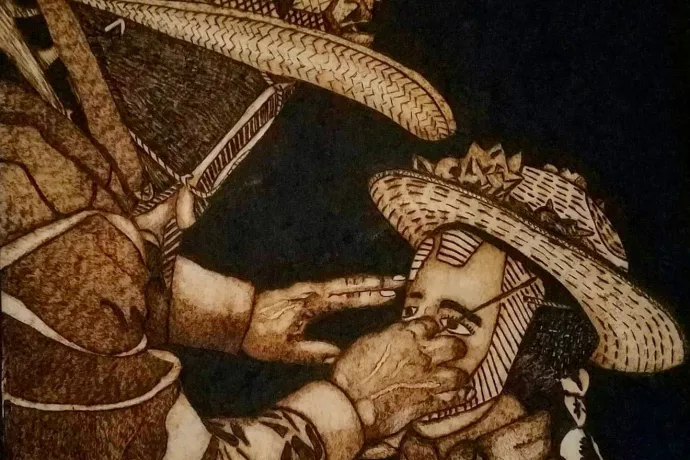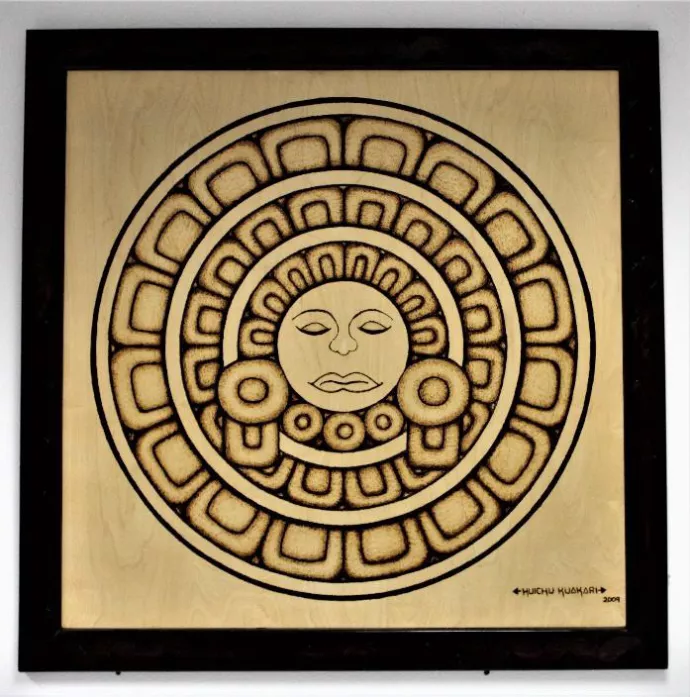
Sharing a way of life: UTM art exhibition from Mexico celebrates P’urhépecha heritage
In one of Huíchu Kuákari’s works of art, an older person is shown putting a mask on a child.
For Kuákari, who has P’urhépecha heritage, this symbolic image has many meanings: preserving culture, passing on traditions, and sharing the P’urhépecha way of life.
It’s also one of 20 original works by Kuákari that are part of the exhibit Broadening access to the Kaxúmbekua (way of life): Saving P’urhépecha culture across English-speaking countries – which is now on display at UTM’s Collaborative Digital Research Space (CDRS).
Each piece of art in the exhibit reflects P’urhépecha heritage, an Indigenous culture from the Michoacán region in central Mexico, which has fought to keep their way of life and language alive since the arrival of European colonizers over 500 years ago.
“Oftentimes when we think about Indigenous people in Mexico, we think about the Aztecs and the Mayans. The P’urhépecha of Mexico are often not known . . . but they were a very important culture, and continue to be very important culture,” explains Kuákari.
“We want to remind people that we are still here, that we have not disappeared, and we are still preserving our culture and language.”
In early March, UTM’s Collaborative Digital Research Space (CDRS) officially opened the new exhibit which is supported by the Black, Indigenous, and Racialized Scholar/Research Grant Program at UTM and CDRS.
The opening also marked the beginning of the new CDRS Art-in-Residence program – a pilot program that will host artists and their works at CDRS each year.
Kuákari says images in the exhibit portray the P’urhépecha’s outlook on life, and also represents what makes them different and distinct from other Mexican people and Indigenous groups.
“In essence, I am presenting different epochs – (for example), the pre-Columbian ones that go back to our traditional deities,” he explains. “I am also presenting a couple of displays of ancestral culture and how it works now, and also, a distinct look at how our community is changing and moving forward. The central component is to share our way of life.”
Kuákari wanted to bring his work to English-speaking countries because he wanted to share the P’urhépecha’s way of life with the broader world.
“The ultimate goal is to share the beauty of our culture with people across the globe, and remind them that we are here, and we still have a lot to share,” he says.
Art, he adds, is a special way to share the P’urhépecha way of life – helping to preserve oral tradition and cultural practices that are on the precipice of being lost.
“What makes art so special is that we can preserve deities, ideas and concepts,” Kuákari says. “I think this exhibit demonstrates the power of art, and the power of transporting messages and ideas to everyone as a whole. It is a way of preserving our culture, and engaging in cultural exchange for anyone who’s interested in learning.”
The exhibit is curated by Jerry Flores, a UTM professor of sociology, as well as Elizabeth Parke from U of T’s Centre for Research and Innovation Support (CRIS).
Flores says the exhibit launch marks the beginning of using CDRS as a dynamic space where the UTM community can engage in cultural exchanges and discussions. The exhibit also honours a commitment of UTM’s Strategic Framework to deepen reciprocal relationships with Indigenous nations and communities.
In the future, Flores hopes he can collaborate with other Indigenous peoples across the Americas to tell their stories and share their cultures with the UTM community.
“I want people to see these pieces of art, and in an ideal world, see bits of themselves and bits of the culture . . . bits of all the positive things that we have to share with one another,” he says. “I want us to build bridges, and I hope that we can continue to have Indigenous artists, BIPOC artists, and people from all over the world come to CDRS.”

